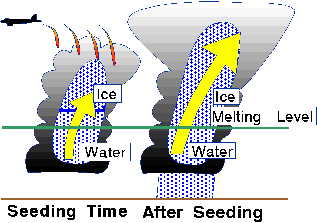
Seeding of tropical cumulus clouds, and indeed any clouds, requires that they contain supercooled water--that is, liquid water colder than zero Celsius. Introduction of a substance, such as silver iodide, that has a crystalline structure similar to that of ice will induce freezing. In mid-latitude clouds, the usual seeding strategy has been based upon the vapor pressure being lower over water than over ice. When ice particles form in supercooled clouds, they grow at the expense of liquid droplets and become heavy enough to fall as rain from clouds that otherwise would produce none. Seeding of tropical cumuli sought to exploit the latent heat released by freezing as well. This strategy of "dynamic seeding" assumed that the additional latent heat would add buoyancy, strengthen the updrafts, ensure more low-level convergence, and ultimately cause explosive growth of properly selected cumuli. The above sketch illustrates an aircraft dispensing pyrotechnics doped with silver iodide into a supercooled cloud that is invigorated by the latent heat released as the boundary between liquid and frozen hydrometeors (blue horizontal line in the cloud on the left) moves down to the zero Celsius isotherm (green horizontal line). It was this transformation that the experimenters hoped to use for construction of an artificial outer eyewall during Project STORMFURY. ReferencesMalkus, J. S., and R. H. Simpson, 1964: Modification experiments on tropical cumulus clouds. Science, 145, 541--548. Willoughby, H. E., D. P. Jorgensen, R. A. Black, and S. L. Rosenthal, 1985: Project STORMFURY, A Scientific Chronicle, 1962-1983, Bull. Amer. Meteor. Soc., 66, 505-514. |
Links of Interest
AOML Tools & Resources
Employee Tools
|
